
Evolution of the Two-handed Backhand
by Dave Smith
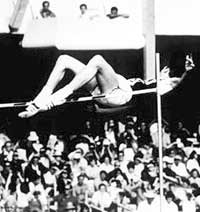 |
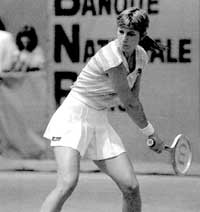 |
|
What did Dick Fosbury and Chris Evert have in common? They both
helped revolutionize their respective sports. |
The Fosbury Flop, Titanium Drivers, Turbo-chargers, Two-handed Backhands… What do all these things have in common? They are all innovations that
helped revolutionize their respective sports. And, the two-handed backhand
in tennis is arguably, one of the greatest technical innovations any sport
has seen. Amazingly, of all the historic tennis competitors, virtually no one
utilized the stroke until 100 years after the sport was invented! I find this even more
interesting since many sports - namely baseball, cricket, hockey, and golf
- used two-handed swing patterns during that same period.
The 1970’s, a decade known for bell bottoms, disco, and polyester
leisure suits, was also a remarkable decade for the sport of tennis.
During this period, the game experienced an incredible surge of
popularity. With the proliferation of new tennis facilities across the
country and large purses of prize money offered in professional
tournaments, tennis became big business. In 1973, over 50,000 spectators
and millions more through television coverage, watched the tennis
spectacle of the decade: Billie Jean King defeating Bobby Riggs in a
$100,000 “Battle of the Sexes.”
The 70’s were also the decade when skilled players began emerging onto
the tennis scene utilizing the two-handed backhand, a stroke that would
begin a significant transformation of the game for the next thirty years.
Two-Hands Makes a Statement
When 17 year-old ingénue, Chris Evert emerged as the number 3 ranked
women’s player in the world, people began to take notice of the mechanics
of her two-handed backhand and its role in helping make her a formidable
champion. At 18, Chris Evert turned pro and promptly earned over $150,000
her rookie year on tour…a lot of money in 1973!
|
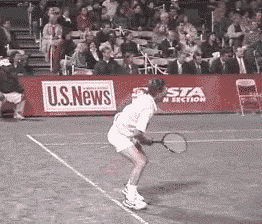
Even as players like Borg and Connors began to dominate the game,
it would be years before the stroke to gain widespread acceptance. |
That same year, two male
players whose names would become synonymous with high-caliber tennis:
Bjorn Borg and Jimmy Connors, first came to prominence. Both men would
reign as enduring champions and both used two-handed backhands to
accomplish this. At 20, Connors became one of the youngest American men to
be ranked number one (Pancho Gonzalez also was ranked number one
twenty-five years earlier).
Interestingly, even as these players dominated men's and women’s tennis
for the next ten years, few other top contenders followed their lead and
employed the two-handed backhand. American Harold Solomon would be one of
few notable men to use the shot in the 70’s. Among the women, American
teen-sensation Tracy Austin was one of the few who would adopt the stroke.
The shot arguably helped her go on to become the number one ranked
American female player in 1980.
Why Two Hands?
As I mentioned in my earlier articles on the
Evolution of the Game, the
first two-handed backhands were more a happenstance than a calculated
stroke preference. Evert was actually discouraged by her father/coach
Jimmy Evert and Borg simply found the two-handed backhand a logical
crossover skill developed from his slap shot used when he played hockey as
a child.
|
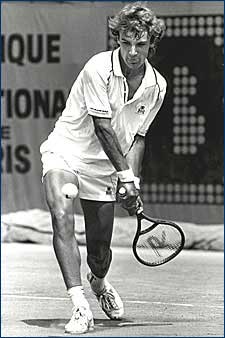
Mats Wilander was among the first of the new breed of two-handers,
but his greatest success came after he added a one-handed slice to his
game. |
While Connors was before Borg, (by a year in terms of major titles,
Connors won the doubles at the French in 1973 and the U.S. Pro Singles
title that same year, Borg won Davis cup matches in 1972 and 1973 but his
first major was the French, in singles in 1974), they existed essentially
in the exact same time frame.
Connors' backhand can be traced to his mother and grandmother's initial
training, probably recognizing that Connors, not a big kid by any means,
would do better early on with a two-hander.
However, two-hander players who subsequently emulated these champions,
(or those who would teach the stroke), discovered an overall advantage
in several components of the shot. These advantages can be traced to the
evolution and increased use of topspin in the modern game.
Players quickly found the two-hand mechanics made for a more stable and
repeatable topspin stroke pattern. The use of the off-hand in pulling the
racquet up the back of the ball through contact helped considerably not
just in developing the topspin stroke itself, but in the increase of
potential topspin as players looked to hit the ball harder. And these
advantages held true for beginners and advanced players alike.
Two-hand Dominance Takes its Time
It would take the tennis teaching establishment time to recognize what
these champions had demonstrated: the two-handed backhand was not a fluke.
Although few other top-ranked players would emerge into the limelight with
the two-handed backhand during the early 1980s, it was becoming
increasingly more popular with the youth of that era.
By the end of that decade, a slew of top young two-handed players were starting to materialize
in the pro ranks. Americans, Mary Joe Fernandez and Andre Agassi along
with Swede, Mats Wilander were among the first of this new breed and by
1989, American Michael Chang and Spain’s Arantxa Sanchez Vicario, both
two-handed backhand players, unexpectedly took top honors at the French
Open Championships.
The 1990’s ushered in more and more men and women champions who were
using this stroke. These included Jim Courier, Goran Ivanisevic, Yevgeny
Kafelnikov, Todd Martin among the men and Jennifer Capriati, Monica Seles,
Conchita Martinez, Mary Pierce, Lindsay Davenport, Martina Hingis, and
Serena and Venus Williams among the women.
|
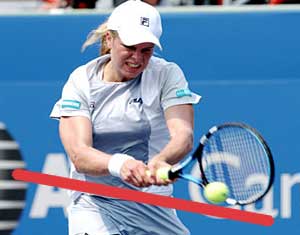 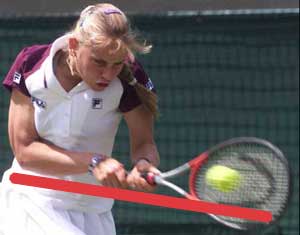
Note both Clijsters and Dokic hit their backhands with the forearm
and racquet forming a straight line from the elbow to the top of the
racquet. |
Two-handed Mechanics
Because of the mechanics, the basic structure of the two-handed
backhand is very similar among most players who use it. However, there are
a few players who have created variations of the two-handed backhand,
which are noteworthy.
Most two-handed backhand players adopt a Continental grip for the lower
dominant hand while the top hand usually takes on an Eastern Forehand
grip. In other words, for right-handed players, the backhand resembles a
left-handed forehand with the left hand. This grip alignment allows the
player to keep the racquet parallel with the forearm of the dominant hand.
|
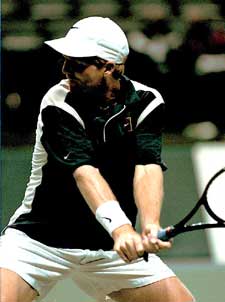
Jim Courier used a strong Eastern backhand grip and hit the ball
extremely far out in front. |
Most of these players keep their dominant arm’s elbow near the body
through contact, utilizing the elbow as a fulcrum (See photos of Clijsters
and Dokic above). The left arm (for
right-handers) clearly resembles the form of a left-handed forehand. This
differs from most one-handed backhands, which utilize an Eastern backhand
grip on the single, dominant hand. The Eastern backhand grip generally
creates a right angle between the racquet and the forearm of the hitting
arm.
Notable exceptions to this conventional backhand would include four rather
distinct variations.
Jim Courier
If you took the traditional one-handed backhand utilizing a strong Eastern
backhand grip, and hit it with two hands, you would closely resemble Jim
Courier’s two-handed backhand. Courier would hit the ball extremely far
out in front of him with the dominant arm held straight and rigid. The
left arm would pivot the racquet head up for topspin in a “windshield
wiper” action.
Jimmy Connors
Certainly one of the innovators in the development of the two-handed
backhand, Jimmy Connors created a simple, yet aggressive stroke that would
set the trend in motion for future generations of dual-handed backhand
players.
|

Bjorn Borg's backhand resembled a hockey player taking a slap shot.
|
Connors, like Courier, maintained a relatively straight left arm, (his
dominant, being left-handed.) Driving the ball with minimal topspin,
Connors utilized the shot for low depth, certainly contributing to his
all-court style of play. However, unlike Courier, Connors favored a
Continental grip for his dominant hand. (Although, some might say it was a
hybrid grip that was somewhat closer to an Eastern forehand grip than a
Continental.)
Bjorn Borg
Hockey player turned tennis player, Bjorn Borg fascinated the tennis
public with not only a steely mental temperament, but a unique and
effective topspin two-handed backhand. Following the advent of greater
topspin by predecessors, Rod Laver and others, Borg took the concept of
topspin to another level. Borg’s form really did resemble a hockey player
ready to backhand a slap shot.
Notably, Borg used a Continental grip on
his right hand, his dominant, and very nearly a Continental grip on his
left hand. The unique feature of his backhand was his backswing. Borg
would lift his left elbow often above his left shoulder bringing the hands
high into his side. Unlike a traditional loop swing, this was almost a
straight back swing pattern, giving Borg time to move to the ball with the
racquet literally back and up prior to him even reaching a ball. His
subsequent whip down and back up the ball was indeed almost a slapping
motion.
Andre Agassi
Agassi has been called one of the finest return-of-serve players in all of
tennis. His short compact swing on both his forehand and his two-handed
backhand have helped make his groundstrokes a formidable weapon. His form
most closely resembles Jimmy Connors’ form, with a straight dominant arm
through the course of his swing. However, he hits the ball with a bit more
closed racquet face and greater brush up on the ball giving his backhand
significantly more topspin.
Agassi favors a Continental grip on the
dominant side, and very nearly a Continental grip on the top hand. Not
unlike Fred Perry in the 1930’s who would often take the ball on the rise
with his body driving forward adding pace to his shots, Agassi often takes
both his forehand and backhand groundstrokes early on the rise after the
bounce, helping to add pace to his strokes.
The Future
The pattern of player development has favored the more traditional
two-handed backhand form, with fewer players preferring any distinctively
different variations. Any innovations in the shot have been predominately
focused on changes in footwork. Today, the two-handed backhand is being
hit with both open and closed stances, with players looking to gain an
edge in quickness and recovery.
|
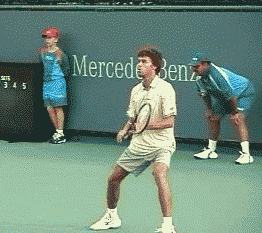
Gustavo Kuerten's one-handed backhand is one of the most beautiful
and effective in the game. |
While the two-handed backhand has become the dominant stroke among both
men and women professionals, we still see a considerable number of
high-ranking players still implementing strong one-handed backhands. Players
like Justine Henin-Hardenne and Amelie Mauresmo on the women’s tour and Pete Sampras and Gustavo Kuerten
among the men.
Watch these talented players hit and you will see the same
characteristics that top two-handers possess: Stability, repeatable swing
patterns and significant topspin. The question for any developing player
is: which stroke should they explore? Obviously, if players develop the
key characteristics I just mentioned—and with earlier success—using the
two-handed backhand, it stands to reason that more and more players will
emerge among the highly skilled using the two-handed backhand. However, it
has been shown that skilled one-handed backhands can compete equally with
skilled two-handed strokes.
Tennis strategies arguably contribute to the use of one or two hands.
Attacking players tend to favor one handed strokes with their ability to charge the net faster using one-handed stroke patterns.
Sampras, Rafter and Henman add credibility to this argument!
Whether the backhand continues to evolve will remain to be seen. However,
in the course of thirty years, we have seen a remarkable change in the
shot among many top players and champions of the sport.
 Your comments are welcome. Let us know what you think about this article by emailing
us here at TennisONE. Your comments are welcome. Let us know what you think about this article by emailing
us here at TennisONE.
David W. Smith is the Director of Tennis for the St. George Tennis Academy
in St. George Utah. He has been a featured writer in USPTA’s magazine
ADDvantage in addition to having over 50 published articles in various
publications. David has taught over 3000 players including many top
national and world ranked players. Dave is also a member of Wilson Racquet
Sports Speaker's Bureau. He can be reached at ACRpres1@msn.com |